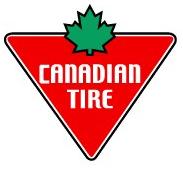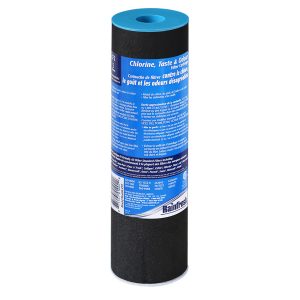Chloramine Filter Cartridge

Specially formulated for chloramine reduction
Chloramines
Chlorine, taste and odour
Sediment
- > 95% reduction of chloramines
- > 95% reduction of chlorine
- 1,000 US gal (3,785L) life
- 5 micron nominal
- Certified to NSF/ANSI 42
- For use with Rainfresh systems
- Also fits most other brands
-
-
For reduction of chloramines in water
Over 11 million Canadians drink water that has been treated with chloramines . Chloramines are formed when ammonia is added to the water along with chlorine to reduce the formation of potentially cancer-causing Trihalomethanes (THMs ). However, chloramines render an offensive taste and odour to drinking water & beverages made from such water. In addition, chloramines can cause skin irritation, are corrosive by nature, and are toxic to fish.Chloramines cannot be removed by boiling, distillation or regular activated carbon filters. The Rainfresh CA1 filter cartridge has been specially
developed and formulated for reduction of chloramines using special grade activated carbon and proprietary media.LIST OF MAJOR CANADIAN MUNICIPALITIES THAT USE CHLORAMINATION
ALBERTA : Edmonton, Lethbridge, Red DeerBRITISH COLUMBIA : Greater VictoriaMANITOBA : DauphinNEWFOUNDLAND : St JohnsONTARIO : Aurora, Brantford, Cambridge, Essex, Grey Bruce, Hamilton, Holland Landing, Kenora, Kitchener, Leamington, Markham, Newmarket, Ottawa, Queensville, Richmond Hill, Sault Ste Marie, Sharon, Toronto, Vaughan, WaterlooSASKATCHEWAN : SaskatoonPERFORMANCE
- Reduces > 98% chloramines, chlorine, taste, odour
FEATURES
- Filters down to 5 micron nominal
- Solid block construction that prevents channeling and bypass
- Top grade activated carbon with proprietary chloramine reduction media certified for material safety
- Universal fit – fits Rainfresh and most standard filter housings
- Single open end
APPLICATIONS
CA1 filter cartridges can be used with
- water filter systems (undersink or inline) for home use (not for whole house use)
- undersink reverse osmosis systems
- commercial kitchens
- laboratory use
INSTALLATION
- Installs with orange (open) gasket facing up
CARTRIDGE LIFE
- CA1 should be replaced after 1,000 US Gal or 6 months of use
- Available at most retail stores in Canada. Click on the “Where to buy” tab for list of retailers
TESTING AND CERTIFICATION
- CA1 is a certified component tested by CSA International to NSF/ANSI 42 for reduction of chloramines, chlorine, taste and odour
-
Download CA1 Chloramine reduction filter cartridge brochure (PDF):
- CA1 Chloramine Filter Brochure English
-
Have more questions? Enter you own question below and our customer service will get back to you within 24 hours.
-
Rainfresh CA1 Chloramine Removal Filter Cartridge removes chloramine, chlorine, bad tastes and odours and sediment from drinking water.
For reduction of chloramines in water
Over 11 million Canadians drink water that has been treated with chloramines . Chloramines are formed when ammonia is added to the water along with chlorine to reduce the formation of potentially cancer-causing Trihalomethanes (THMs ). However, chloramines render an offensive taste and odour to drinking water & beverages made from such water. In addition, chloramines can cause skin irritation, are corrosive by nature, and are toxic to fish.Chloramines cannot be removed by boiling, distillation or regular activated carbon filters. The Rainfresh CA1 filter cartridge has been specially
developed and formulated for reduction of chloramines using special grade activated carbon and proprietary media.LIST OF MAJOR CANADIAN MUNICIPALITIES THAT USE CHLORAMINATION
ALBERTA : Edmonton, Lethbridge, Red DeerBRITISH COLUMBIA : Greater VictoriaMANITOBA : DauphinNEWFOUNDLAND : St JohnsONTARIO : Aurora, Brantford, Cambridge, Essex, Grey Bruce, Hamilton, Holland Landing, Kenora, Kitchener, Leamington, Markham, Newmarket, Ottawa, Queensville, Richmond Hill, Sault Ste Marie, Sharon, Toronto, Vaughan, WaterlooSASKATCHEWAN : SaskatoonPERFORMANCE of chloramine removal filter cartridge
- Reduces > 98% chloramines, chlorine, taste, odour
FEATURES of chloramine removal filter cartridge
- Filters down to 5 micron nominal
- Solid block construction that prevents channeling and bypass
- Top grade activated carbon with proprietary chloramine reduction media certified for material safety
- Universal fit – fits Rainfresh and most standard filter housings
- Single open end
APPLICATIONS of chloramine removal filter cartridge
CA1 chloramine removal filter cartridge can be used with
- water filter systems (undersink or inline) for home use (not for whole house use)
- undersink reverse osmosis systems
- commercial kitchens
- laboratory use
INSTALLATION
- Installs with orange (open) gasket facing up
chloramine removal filter cartridge LIFE
- CA1 chloramine removal filter cartridge should be replaced after 1,000 US Gal or 6 months of use
- Available at most retail stores in Canada. Click on the “Where to buy” tab for list of retailers
TESTING AND CERTIFICATION
- CA1 is a certified component tested by CSA International to NSF/ANSI 42 for reduction of chloramines, chlorine, taste and odour
-
Reviews
Add a review Cancel reply









Good So Far
After allowing a day to flush out, the filtered water has no chlorine smell and the taste is very very close to bottled water.
Customer from Oshawa, ON
April 21, 2016
Been a good filter for Chloramines here in Victoria, BC.
However, beware of the need for extensive flushing of loose or fine carbon particles, that will need to be scrubbed from the now-clogged ceramic stage filter.
Hello Wayne, thanks for your comment. All carbon blocks will give off some fines when they are first installed. As explained in the unit instructions, when you install a new cartridge, remove the ceramic cartridge and flush the cartridge by opening the faucet for a couple of minutes. Re-install the ceramic cartridge and you will not see any fines on the ceramic. We hope you continue to enjoy clean, safe water !!